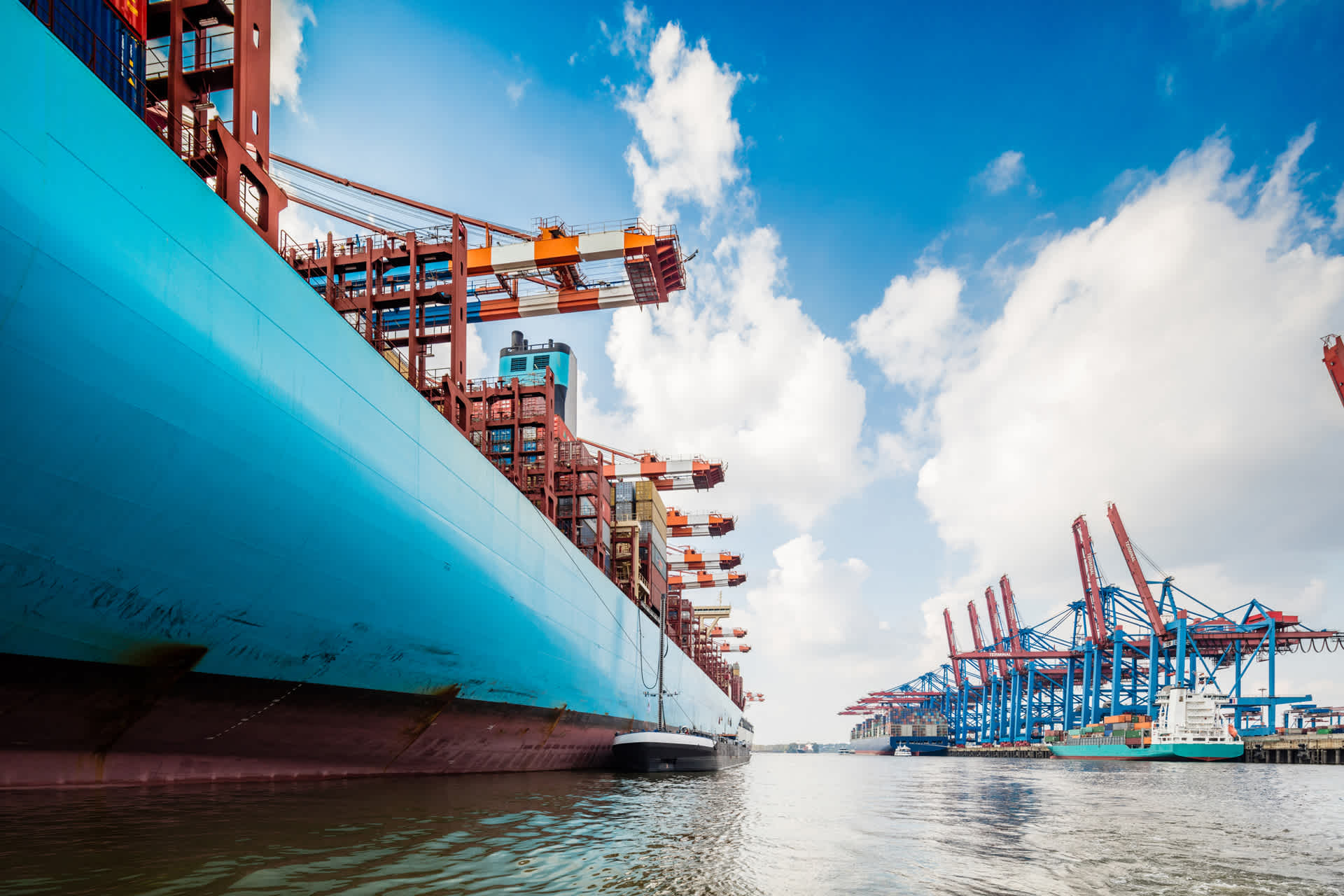Global Logistics Update
Freight Market Update: April 5, 2022
Ocean and air freight rates and trends; customs and trade industry news plus Covid-19 impacts for the week of April 5, 2022.
Freight Market Update: April 5, 2022
North America Freight Market Update Live | Thurs, April 7 @ 8:30 am PT / 11:30 am ET
Ocean Freight Market Update
Asia → North America (TPEB)
- Lockdown remains in place in Shanghai and are impacting suppliers and causing headaches for shippers and importers. Ocean carriers continue to assess impacts to bookings and have not yet announced any blank sailings, but expect that there will be changes to bookings. There is uncertainty around whether softening currently being seen in the market is expected to last, as post-CNY lulls in demand are traditional and inventory replenishment efforts remain for importers and retailers. Severe congestion, equipment imbalances, sliding vessel schedules, port omissions, blank sailings, and increased fuel charges continue to create challenges.
- Rates Rate levels remain elevated and the premium market is strong.
- Space Undercapacity, except in pockets
- Capacity/Equipment Critical/Severe Undercapacity
- Recommendation Book at least 3-4 weeks prior to CRD. Consider premium options. Be flexible in regard to equipment and routings. Check closely with suppliers to understand any Covid-related impacts or changes to production outputs and forecasts.
Asia → Europe (FEWB)
- Shanghai continues to be under an extended lockdown with another round of mass testing announced. This is impacting factory production, warehousing, and trucking availability although port terminals and trucking do continue to be fully operational. There is available space on FAK and spot across all alliances but carriers are still not open for more long-term named accounts. It is expected that there will likely be some port omissions and blank sailings announced by carriers as a response to recent developments.
- Rates Rates remain at a high level but have been on a downward trend since March and going into April due to a slowdown in the market.
- Space Tight space situation
- Capacity/Equipment Severe equipment shortage across all Asia origins.
- Recommendation Book at least 2 to 3 weeks prior to CRD. Be flexible in regard to equipment
Europe → North America (TAWB)
- Congestion at USEC ports has not improved so far only 2 ports are running at an almost normal pace. USWC is improving with vessel waiting time now around 22-25 days for LAX and LGB.
- Rates Ocean levels continue to rise with PSS and GRI increases announced for April rates.
- Space Critical, especially to the USWC and also on the USEC going into Q2
- Capacity/Equipment Capacity remains tight for both North Europe and Mediterranean services. Better equipment availability at port. Shortages remain at inland depots.
- Recommendation: Book 5 or more weeks prior to CRD. Request premium service for higher reliability and no-roll guarantees.
Indian Subcontinent → North America
- Ongoing political uncertainty and Covid related delays continue to affect the ISC region. Rising political tensions in Sri Lanka and Pakistan are causing concern for local shippers. Sri Lanka has implemented measures to ration fuel which is having a direct impact on heavy equipment and trucking capacity. Local rate increases and delays are to be expected. Ongoing Covid-19 shutdowns in China will negatively impact empty equipment supply in the ISC region, as China remains a key source for equipment repositioning.
- Rates sustained at high levels into April. Expect rates to increase for India and Bangladesh ports that require transhipment in Colombo/Singapore/Malaysia due to increased costs for feeder vessel services.
- Space to the USWC will remain a challenge for 2022. Port omissions on services to the USWC continue to cut capacity out of the Indian sub-continent. Recommendation is to move on premium services. Space to the USEC remains constrained as ongoing USEC congestion at main ports of discharge such as Savannah and Charleston are creating delays in the return trips back to the ISC region. These delays often result in port of loading omissions and blank sailings.
- Equipment deficits are being reported across many ports in India. Most affected are the S/SE ports, Kolkata, and Inland container depots in North India.
- Recommendation remains to load via wet port and avoid Inland container depots when possible. ICDs are a chokepoint for containers which often leads to delays in SO release. Booking on some premium services will give you priority on equipment.
North America → Asia
- Vessel arrivals and available capacity remain fluid for USWC POLs. USEC situation sees Savannah operations improving however Charleston continues to be congested and subject to omissions on certain strings. Erratic vessel schedules continue to create void sailings and delays in schedules creating significant challenges with posted earliest return dates and vessel cut-offs at the port.
- Rates Limited GRI activity announced for late April and early May.
- Equipment Deficits on containers and chassis continue to plague IPI origins. Availability for standard equipment at ports has not been an issue for most ports but there have been shortages on 40’s at the port of Oakland.
- Recommendation Please place bookings 4 weeks prior to vessel ETD.
North America → Europe
- Significant congestion and vessel delays in Europe still remain in addition to the ongoing schedule issues for New York, Charleston, and Savannah that are now leading to bi-weekly port omissions. US West Coast service to Europe is extremely tight due to void sailings and skipped ports caused by systematic delays. Pacific Northwest coverage for Europe is suspended indefinitely. All carriers have issued a booking stop for shipments to Ukraine, Russia, and Belarus.
- Rates No GRI announced for May as of yet.
- Equipment Deficits are still plaguing IPI origins. Availability for standard equipment at ports has not been an issue, but any special equipment is hard to come by.
- Recommendation Please place bookings 3 to 4 weeks in advance for East Coast/Gulf sailings and 6 weeks for Pacific Coast sailings.
Air Freight Market Update
Europe
- Demand continues to increase, the upcoming change in season is seeing an increase in air freight requests for inventory to be stocked for Summer. To ensure goods arrive quickly, consider smaller batches of cargo across multiple uplifts.
Rates are at a stable high due to capacity constraints, Jet fuel prices starting to decrease however the benefits will not be passed on till the market stabilizes.
Freighter capacity is heavily reduced and booking to uplift window is approx 10-14 days.
Deferred routings are still providing a viable routing option if already tight lead times can take it. We also see cheaper options on the market to secondary hubs where airlines have regular passenger flights.
Less congestion at EU terminals, though high volumes, therefore a potential increased transit time.
Americas
- Demand remains high, especially into central Europe hubs. Origin dwell times of 3-5 days have been reported.
- Most airlines are canceling flights into PVG due to the current COVID-related lockdown.
- Transatlantic passenger capacity has increased to almost pre-covid levels.
- Early bookings are highly suggested.
- LAX/ORD/JFK ground-handlers are dealing with high volume considering the heavy export throughput.
- Most terminals provide reduced free time for storage and have earlier close-outs for exports to accommodate throughput times and screening requirements.
- Rates to Asia, LATAM, and Europe have increased further.
Trucking & Intermodal
Americas
- US Domestic Trucking
- Demand is dropping, creating more capacity for the first time in quite a while. The Outbound Tender Volume Index has fallen below 14,000 to 13,783, and the Outbound Tender Rejection index has fallen to 16.10%. There are less tenders and providers are accepting more of their contracted freight.
- The National DAT Load-to-Truck ratio has dropped to (4.44 loads per 1 truck), which represents the lowest LTT ratio that we have seen since January of 2021. While low, it is still nowhere near a balanced market, as a balanced market is represented by a LTT ratio closer to (2.5 to 1).
- It remains a possibility that the market we are seeing is a return to seasonality, albeit a slightly delayed return that was impacted by severe winter weather and Omicron in January and February. And truly, the answer could be both, we could be seeing the market drop off as consumer spending patterns change. A highly fragmented carrier market remains which is highly susceptible to market-induced capacity swings.
- The South East and Houston, TX markets are thought to be stronger than their surrounding market, particularly when the South East hits produce season in Mid-April/May Produce Season will cause a capacity crunch in these areas for dry van and especially reefer freight, causing spot rates to rise.
- The Midwest is cooling rapidly. Chicago is falling below equilibrium at (1.58 to 1), Detroit (2.16), and Milwaukee, WI (2.44) also fell below equilibrium, and as a by-product, we should see spot rates accelerate their decline out of these markets. The North East cooled, with Elizabeth, NJ (4.56), Philadelphia, PA (3.46), Harrisburg, PA (4.20), and Baltimore, MD (4.24) continuing to inch down.
- Plenty of markets increased as we continue to see some seasonality as Norfolk, VA (port market) hit 8.52 to 1, Miami, FL (port market) 6.56 to 1, Jacksonville, FL (port market) 8.24 to 1, and Los Angeles, CA moved back up to 6.24 to 1.
- US Import/Export Trucking
- Market Trends
- Congestion continues across the majority of East Coast ports, however, some markets in recent weeks have seen a slowdown in inbound container volumes.
- Limited warehouse receiving capacity continues to be an issue as inventory levels increase. Backlogged containers waiting to unload absorb valuable chassis equipment and yard space, which in turn disrupts trucking productivity.
- Port of LA/LB approved a clean truck fee to be assessed on cargo owners beginning April 1, 2022. The plan is designed to expedite the introduction of zero-emission vehicles in the port complex.
- The fee is $10 per TEU, or $20 for all containers longer than 20'
- Profits raised from the fee will be used in part to provide direct grants to truckers for zero-emission vehicles.
- Both new and existing cartage providers have doubled down on their air export service. Same-day pickups are consistently achieved in each of our major markets. We continue to build out the linehaul service to support expedited movement on the backhaul to our major gateways.
- Market Trends
- Q2 2022 Outlook
- Volatility in FSC is expected to continue as Diesel prices remain unstable and on the raise.
Customs and Compliance News
CBP Announces Go Live Date for New Exclusion
CBP issued an alert to the trade community on the go-live functionality of the new code related to the recent tranche of 352 exclusion extensions the US Trade Representative (USTR) reinstated. The exclusion code will go live on April 12, 2022. Importers seeking to apply the exclusion on historical or future shipments should contact their broker to ensure product eligibility.
CIT Rules in Favor of USTR on Section 301 List 3 and 4A Tariffs
On April 1, the Court of International Trade ruled the USTR had the statutory authority to impose the additional List 3 and 4A Section 301 tariffs on goods from China. The CIT ruled against the plaintiffs' argument that the USTR illegally imposed the Section 301 tariffs because the US government was responding to retaliatory tariffs from China rather than as a result of an investigation into unfair trade practices. However, because the USTR failed to appropriately address comments from the trade community on the tariffs’ imposition, the CIT is giving the USTR 90 days to do so. Any outcome will likely be appealed to the Court of Appeals for the Federal Circuit.
Factory Output News
- Vietnam warns of electricity shortages due to tight coal supplies Source
- Vietnam’s automaker Vinfast to build first manufacturing factory in the US Source
- Cambodia aims to shift production into more complex and higher value-added components in the automotive and electrical manufacturing sectors Source
- Thailand BMW Thailand in discussions with parent company to produce EV locally Source
- Thailand aims for 10% growth for the export sector Source
- Malaysia Strong growth expected for Malaysia’s electrical and electronics exports Source
- Indonesia The carbon tax that was set to roll-out in April has been delayed to July to aid economic recovery amid rising energy prices. Source
- Indonesia and Romania strengthen bilateral cooperation in all fields such as trade. Indonesia can penetrate the EU region with their local products by using the Constanta port as a point of entry. Source
Freight Market News
Additional China lockdown further restricts supply chains
FreightWaves reports that Kunshan is the latest Chinese city to implement a lockdown to contain the spread of Covid. As Kunshan is an important production center for electronics components, there will likely be a severe impact on the supply of laptops, cellphones, and automobiles. Meanwhile, Shanghai has extended their lockdown indefinitely, with impacts to trucking services and air rerouting mounting.
Container Freight Rates Above Par, Despite Global Issues
The Loadstar reports that container spot rates, while trending down, are generally consistent with the normal seasonal falls, and that ocean carriers are successfully securing contract rate increases. In the near term, the lack of available containers to load in China is likely to cause carriers to discount rates to capture as much cargo as possible.
Flexport Research Updates
Fueling the Boom - Flexport Weekly Economic Report
To go on a goods buying spree, it helps to have money. This week’s Economic Report from the Flexport Research team looks at trends in real disposable income for American consumers and looks at how compensation is partially replacing government transfers. The balance has meant lowering income but steady consumption—so far.
The Air Timeliness Indicator measures the amount of time taken to move airfreight along two major trade lanes from the point of consolidation to arrival at final destination. Last week the Transpacific Eastbound (TPEB) improved for the 11th straight week while Far East Westbound (FEWB) worsened slightly. The TPEB fell to 11.1 days in the four weeks to April 3, down 0.4 days on the week and by nearly six days from its mid-January peak. FEWB worsened to 10.2 days in the four weeks to April 3.
Both face disruptions from the resurgence of COVID-19 related lockdowns in China. There was also an increase on FEWB in “origin to depart destination,” which includes flight times and may represent a continued impact of the conflict in Ukraine.
The Ocean Timeliness Indicator similarly measures transit time for ocean freight along the same two trade lanes. In the past week, the TPEB decreased for the first time in four weeks, falling to 108. The FEWB was increased to 116 days, a new record for these delays that is largely due to increased handling times in Asia (see below) and longer voyage times, though it isn’t clear what additional impacts the conflict in Ukraine and associated disruptions to ocean shipping have had.
Flexport’s Logistics Pressure Matrix (LPM) gathers 10 data points in an attempt to provide a picture of the challenges facing logistics networks from the demand side and a view of ongoing activity on US-inbound routes. In the latest update, a key measure of consumer spending preferences and industrial import expectations both indicated the potential for declining demand. On the activity side, ocean shipping rates and both the Ocean Timeliness and Air Timeliness Indicators fell, indicating reduced pressure on networks.
Freight Market Update is a complimentary service from Flexport, the modern freight forwarder. If you're not already a subscriber, we invite you to subscribe here.
Please note that the information in our publications is compiled from a variety of sources based on the information we have to date. This information is provided to our community for informational purposes only, and we do not accept any liability or responsibility for reliance on the information contained herein.


